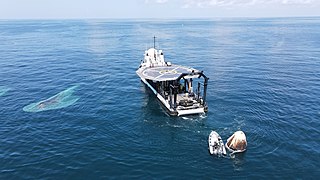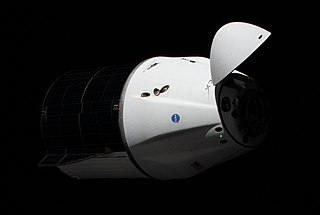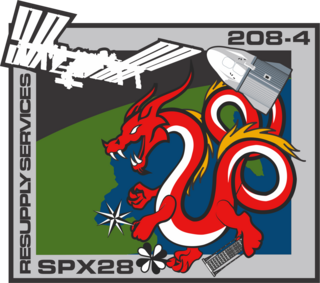
Soichi Noguchi is a Japanese aeronautical engineer and former JAXA astronaut. His first spaceflight was as a mission specialist aboard STS-114 on 26 July 2005 for NASA's first "return to flight" Space Shuttle mission after the Columbia disaster. He was also in space as part of the Soyuz TMA-17 crew and Expedition 22 to the International Space Station (ISS), returning to Earth on 2 June 2010. He is the sixth Japanese astronaut to fly in space, the fifth to fly on the Space Shuttle, and the first to fly on Crew Dragon.
American private space transportation company SpaceX has developed and produced several spacecraft named Dragon. The first family member, now referred to as Dragon 1, flew 23 cargo missions to the ISS between 2010 and 2020 before retiring. With this first version not designed for carrying astronauts, it was funded by NASA with $396 million awarded through the Commercial Orbital Transportation Services (COTS) program, with SpaceX being announced as a winner of the first round of funding on August 18, 2006.

Dragon 2 is a class of partially reusable spacecraft developed and manufactured by American aerospace manufacturer SpaceX, primarily for flights to the International Space Station (ISS). SpaceX also launches private missions, such as Inspiration4 and Axiom Mission 1. There are two variants of the Dragon spacecraft: Crew Dragon, a spacecraft capable of ferrying four crewmembers, and Cargo Dragon, an updated replacement for the original Dragon 1 used to carry freight to and from space. The spacecraft consists of a reusable space capsule and an expendable trunk module. The spacecraft launches atop a Falcon 9 Block 5 rocket and the capsule returns to Earth through splashdown.

Crew Dragon Demo-1 was the first orbital test of the Dragon 2 spacecraft. The mission launched on 2 March 2019 at 07:49:03 UTC, and arrived at the International Space Station on 3 March 2019, a little over 24 hours after the launch. The mission ended following a successful splashdown on 8 March 2019 at 13:45:08 UTC.

Crew Dragon Demo-2 was the first crewed test flight of the Crew Dragon spacecraft. The spacecraft, named Endeavour, launched on 30 May 2020 on a Falcon 9 booster, and carried NASA astronauts Douglas Hurley and Robert Behnken to the International Space Station in the first crewed orbital spaceflight launched from the United States since the final Space Shuttle mission in 2011, and the first ever operated by a commercial provider. Demo-2 was also the first two-person orbital spaceflight launched from the United States since STS-4 in 1982. Demo-2 completed the validation of crewed spaceflight operations using SpaceX hardware and received human-rating certification for the spacecraft, including astronaut testing of Crew Dragon capabilities on orbit.

Boeing Crew Flight Test will be the first crewed mission of the Boeing Starliner and the third orbital flight test of the Starliner overall after the two uncrewed flight tests, OFT-1 and OFT-2 in 2019 and 2022.

Expedition 65 was the 65th long duration expedition to the International Space Station. The mission began on 17 April 2021, with the departure of Soyuz MS-17, and was initially commanded by NASA astronaut Shannon Walker serving as the third female ISS commander, who launched in November 2020 aboard SpaceX Crew-1 alongside NASA astronauts Michael S. Hopkins and Victor J. Glover, as well as JAXA astronaut Soichi Noguchi. They were joined by the crew of Soyuz MS-18, which is made up of Russian cosmonauts Oleg Novitsky and Pyotr Dubrov, as well as NASA astronaut Mark Vande Hei.

SpaceX CRS-21, also known as SpX-21, was a Commercial Resupply Service mission to the International Space Station which launched on 6 December 2020. The mission was contracted by NASA and was flown by SpaceX using a Cargo Dragon 2. This was the first flight for SpaceX under NASA's CRS Phase 2 contract awarded in January 2016. This was also the first Cargo Dragon of the new Dragon 2 variant, as well as the first Cargo Dragon flight that was docked at the same time as a Crew Dragon spacecraft. This mission used Booster B1058.4, becoming the first NASA mission to reuse a booster previously used on a non-NASA mission. This was also first time SpaceX launched a NASA payload on a booster with more than one previous flight.

Soyuz MS-18 was a Soyuz spaceflight that was launched on 9 April 2021 at 07:42:41 UTC. It transported three members of the Expedition 64 crew to the International Space Station (ISS). Soyuz MS-18 was the 146th crewed flight of a Soyuz spacecraft. The launching crew consisted of a Russian commander, a Russian flight engineer, and an American flight engineer of NASA. The spacecraft returned to Earth on 17 October 2021 following 191 days in space. The flight served as the landing vehicle for the Russian film director Klim Shipenko and actress Yulia Peresild who launched to the ISS aboard Soyuz MS-19 and spent twelve days in space in order to film a movie, Vyzov.

SpaceX CRS-22, also known as SpX-22, was a Commercial Resupply Services (CRS) mission to the International Space Station (ISS) that launched at 17:29:15 UTC on 3 June 2021. The mission is contracted by NASA and is flown by SpaceX using a Cargo Dragon 2. This is the second flight for SpaceX under NASA's CRS Phase 2 contract awarded in January 2016.

Axiom Mission 1 was a privately funded and operated crewed mission to the International Space Station (ISS). The mission was operated by Axiom Space out of Axiom's Mission Control Center MCC-A in Houston, Texas. The flight launched on 8 April 2022 from Kennedy Space Center in Florida. The spacecraft used was a SpaceX Crew Dragon. The crew consisted of Michael López-Alegría, an American born in Spain and a professionally trained astronaut hired by Axiom, Eytan Stibbe from Israel, Larry Connor from the United States, and Mark Pathy from Canada.

Crew Dragon Resilience is a Crew Dragon spacecraft manufactured by SpaceX and built under NASA's Commercial Crew Program. In November 2020, it was launched into orbit to the International Space Station as part of the Crew-1 mission. With crew prompting, Resilience docked autonomously to the station at 04:01 UTC on 17 November 2020, or Day 2 of the mission, marking the first operational docking of a Crew Dragon and the first operational docking of the Commercial Crew Program. The mission carried four additional members of Expedition 64 to the three already on station.

Crew Dragon Endeavour is a Crew Dragon spacecraft manufactured and operated by SpaceX and used by NASA's Commercial Crew Program. As of 2023 it has successfully completed four crewed missions to the International Space Station (ISS). It was first launched into orbit atop a Falcon 9 rocket on 30 May 2020 and successfully docked to the International Space Station (ISS) as part of the Crew Dragon Demo-2 mission. This was the first crewed flight test of a Dragon capsule, carrying Doug Hurley and Bob Behnken on first crewed orbital spaceflight from the United States since STS-135 in July 2011 and the first crewed orbital spaceflight by a private company. On 2 August 2020 it returned to Earth. The spacecraft was named by Hurley and Behnken after the Space ShuttleEndeavour, aboard which they first flew into space during the STS-127 and STS-123 missions, respectively. The name Endeavour is also shared by the command module of Apollo 15. The spacecraft's second mission, Crew-2, ended 8 November 2021 after having spent almost 200 days in orbit. Crew Dragon Endeavour set the record for the longest spaceflight by a U.S. crew vehicle previously set by her sibling Crew Dragon Resilience on 2 May 2021. Collectively, Endeavour has spent 280 days in orbit and is the crewed space capsule with most time spent in orbit so far.

Crew Dragon C204 was part of Crew Dragon flight vehicle SN 2-1 manufactured and operated by SpaceX and used by NASA's Commercial Crew Program. Used in the uncrewed Demo-1 mission, it was launched atop a Falcon 9 rocket on 2 March 2019, arriving at the International Space Station on 3 March 2019. It was the first orbital test flight of the Dragon 2 spacecraft. The spacecraft was unexpectedly destroyed on 20 April 2019 during a separate test when firing the SuperDraco engines at Landing Zone 1.

SpaceX Crew-2 was the second operational flight of a Crew Dragon spacecraft, and the third overall crewed orbital flight of the Commercial Crew Program. The mission was launched on 23 April 2021 at 09:49:02 UTC, and docked to the International Space Station on 24 April at 09:08 UTC.

SpaceX Crew-3 was the fourth operational flight of a Crew Dragon spacecraft, and the third overall crewed orbital flight of the Commercial Crew Program. The mission successfully launched on 11 November 2021 at 02:03:31 UTC to the International Space Station. It was the maiden flight of Crew Dragon Endurance.

SpaceX Crew-4 was the Crew Dragon's fourth NASA Commercial Crew operational flight, and its seventh overall crewed orbital flight. The mission launched on 27 April 2022 at 07:52 UTC before docking with the International Space Station (ISS) at 23:37 UTC. It followed shortly after the private Axiom 1 mission to the ISS earlier in the month utilizing SpaceX hardware. Three American (NASA) astronauts and one European (ESA) astronaut were on board the mission.

SpaceX CRS-26, also known as SpX-26, was a Commercial Resupply Service mission to the International Space Station (ISS) launched on 26 November 2022. The mission was contracted by NASA and flown by SpaceX using a Cargo Dragon. This was the sixth flight for SpaceX under NASA's CRS Phase 2 contract awarded in January 2016.

SpaceX CRS-28, also known as SpX-28, is a Commercial Resupply Service mission to the International Space Station (ISS) launched on 5 June 2023. The mission was contracted by NASA and flown by SpaceX using Cargo Dragon C208. It was the eighth flight for SpaceX under NASA's CRS Phase 2.































